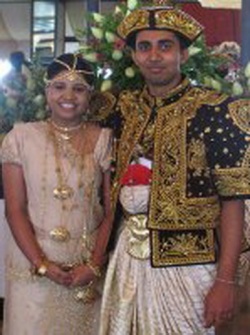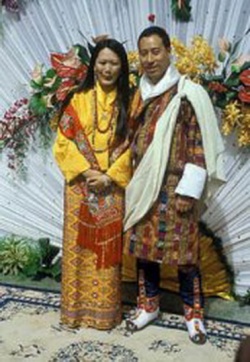Marriage
Marriage (āvāhavihvha) is the formal and legal joining of a man and a woman which usually takes place in a ceremony called a wedding. It is a secular institution, an arrangement between two people or two families and Buddhism does not insist upon monogamy, polygamy, polyandry or any other form of marriage. There were several forms of marriage in ancient India, the most common being those arranged by the parents or guardians, those where the couple chose each other with the parents approval, and elopement. The ancient law books called this second form Svayaṃvara and the third Gāndharva. It still occasionally happened in some of the less civilized parts of northern India that people would ‘abduct others’ wives and daughters and compel them to live with them,’ a custom the Buddha considered socially detrimental (D.II,74). It was thought good for the bride and groom to be the same age (tulyavaya), ideally 16, although the Kāma Sūtra recommends that the bride be three years younger than the groom. The Buddha thought it inappropriate for old men to marry women much younger than themselves (Sn.110) and he considered adultery to be against the third Precept.
Traditionally, Buddhists practised the form of marriage which prevailed in the society in which they lived. Although the Buddha did not advocate any particular form of marriage, we can assume that he favoured monogamy. His father Suddhodana had two wives and as a prince he could have had several wives also, but he chose to have only one. In a discourse on marriage, the Buddha only discusses monogamy, again implying that he accepted this as the best form of marriage (A.IV,91).He said that if a woman lacks merit she might have to contend with a co-wife (sapattī, S.IV,249) and the Tipiṭaka discusses the disadvantages of polygamy for women. ‘Being a co-wife is painful.’ (Thi.216), ‘A woman's worst misery is to quarrel with her co-wives.’ (Ja.IV,316). Such problems are confirmed by the Kāma Sūtra which describes the tensions and manoeuvrings between several wives in the same household. There seems little doubt that it was for these reasons that the Jātaka counseled: ‘Do not have a wife in common with other’(Ja.VI,286).
Having been both a husband and a father, the Buddha was able to speak of marriage and parenthood from personal experience. A husband, he said, should honour and respect his wife, never disparage her, be faithful to her, give her authority and provide for her financially. A wife should do her work properly, manage the servants, be faithful to her husband, protect the family income and be skilled and diligent (D.III,190). He said that a couple who are following the Dhamma will ‘speak loving words to each other’ (aññamañña piyaṃvādā, A.II,59) and that ‘to cherish one’s children and spouse is the greatest blessing’ (puttadārassa saṅgaho ... etaṃ maṅgalam uttamaṃ, Sn.262). He said that ‘a good wife is the supreme soulmate’ (bharyā va paramā sakhā, S.I,37) and the Jātaka comments that a husband and wife should live ‘with joyful minds, of one heart and in harmony’ (pamodamānā ekacittā samaggavāsaṃ, Ja.II,122). The Buddha criticized the brahmans for buying their wives rather than ‘coming together in harmony and out of mutual affection’ (sampiyena pi saṃvāsaṃ samaggatthāya sampavattenti, A.II,222), implying that he thought this a far better motive for marriage. ‘In this world, union without love is suffering’ says the Jātaka (lokismiṃ hi appiyasampayogo va dukkha, Ja.II,205).According to the Buddha's understanding, if a husband and wife love each other deeply and have similar kamma, they may be able to renew their relationship in the next life (A.II,161). He also said that the strong affinity two people feel towards each other might be explained by them having had a strong love in a previous life. ‘By living together in the past and by affection in the present, love is born as surely as a lotus is born in water’ (Ja.II,235). This idea is elaborated in the Mahāvastu: ‘When love enters the mind and the heart is joyful, the intelligent man can say certainty, "This woman has lived with me before" ’ (Mvu.III,185).
The ideal Buddhist couple would be Nakulapitā and Nakulamātā who were devoted disciples of the Buddha and who had been happily married for many years. Once Nakulapitā told the Buddha in the presence of his wife: ‘Lord, ever since Nakulamātā was brought to my home when I was a mere boy and she a mere girl, I have never been unfaithful to her, not even in thought, let alone in body.’ (A.II,61). On another occasion, Nakulamātā devotedly nursed her husband through a long illness, encouraging and reassuring him all the while. When the Buddha came to know of this, he said to Nakulapitā: ‘You have benefitted, good sir, you have greatly benefitted, in having Nakulamātā full of compassion for you, full of love, as your mentor and teacher.’ (anukampikā, atthakāmā, ovādikā, anusasikā, A.III,295-8). From the Buddhist perspective, these qualities would be the recipe for an enduring and enriching relationship – faithfulness, mutual love and compassion and being each others’ spiritual mentor and teacher.
It seems that throughout history most ordinary Buddhists have been monogamous, although kings were sometimes polygamous and polyandry was common in Tibet until just recently. In the highlands of Sri Lanka during the medieval period polyandry was practised, and it still is in parts of Ladakh and Spiti. Today, monogamy is the only legally accepted form of marriage in all Buddhist countries. There is no specific Buddhist wedding ceremony; different countries have their own customs which monks do not perform or participate in. However, just before or after the wedding the bride and groom often go to a monastery to receive a blessing from a monk. See Divorce and Yasodharā.
‘Marriage in the Buddhist Tradition’, B. C. Law, Indian Historical Quarterly, 2, 1926

